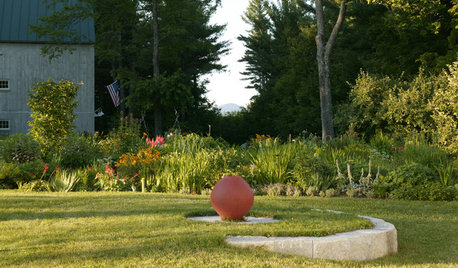When do you plant beans?
leira
12 years ago
Related Stories

SUMMER FRUITS AND VEGETABLESSummer Crops: How to Grow Beans
Grow your own beans for amazing variety and healthy, convenient produce all summer
Full Story
GARDENING GUIDESWhen and How to Plant a Tree, and Why You Should
Trees add beauty while benefiting the environment. Learn the right way to plant one
Full Story
GARDENING GUIDESGot Frost-Damaged Plants? How It Happens, and When and How to Prune
Crispy brown leaves are a sure sign that Jack Frost has been to your neighborhood
Full Story
CONTAINER GARDENSContainer Garden Basics: How and When to Water Potted Plants
Confused about soil moisture, the best time to water and what watering device to use? This guide can help
Full Story
LANDSCAPE DESIGNWhen Less Is Really More in Your Garden
8 ways you can make a powerful garden statement by embracing simplicity and surroundings
Full Story
FUN HOUZZWhat You Do When There’s No One Around
Ice cream binges, air guitar concerts, napping in the closet. Houzzers worldwide disclose their quirky secret indulgences
Full Story
DECORATING GUIDESHow to Decorate When You're Starting Out or Starting Over
No need to feel overwhelmed. Our step-by-step decorating guide can help you put together a home look you'll love
Full Story
CONTRACTOR TIPSBuilding Permits: When a Permit Is Required and When It's Not
In this article, the first in a series exploring permit processes and requirements, learn why and when you might need one
Full Story
DECORATING GUIDESBean There, Done That: Coffee Table Alternatives
Get creative with these ideas for salvaged and DIY pieces that will get people talking
Full Story
Bean Bags: A Surprising Answer for Chic Comfort
Sink into a new generation of squishy, go-anywhere seating
Full StoryMore Discussions







pnbrown
stuffradio
Related Professionals
Holly Springs Landscape Architects & Landscape Designers · Maple Valley Landscape Architects & Landscape Designers · Jennings Landscape Architects & Landscape Designers · Mount Wilson Landscape Architects & Landscape Designers · Wilmington Landscape Contractors · Bristol Landscape Contractors · Coeur d'Alene Landscape Contractors · Del Aire Landscape Contractors · Las Vegas Landscape Contractors · Munster Landscape Contractors · Santa Ana Landscape Contractors · Shirley Landscape Contractors · Bear Driveway Installation & Maintenance · Grayslake Driveway Installation & Maintenance · New River Driveway Installation & Maintenancesunnibel7 Md 7
leiraOriginal Author
pnbrown
leiraOriginal Author
jolj
aloha10
pitcom
pnbrown
Jon_dear
susan2010
eahamel
zeedman Zone 5 Wisconsin
leiraOriginal Author
zeedman Zone 5 Wisconsin
pnbrown
mandolls
leiraOriginal Author
pnbrown
leiraOriginal Author
lolauren
denninmi
ltilton
leiraOriginal Author
pnbrown
leiraOriginal Author